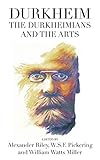Durkheim, the Durkheimians, and the Arts / ed. by Alexander Tristan Riley, ‹a›W. S. F. Pickering‹/a›, William Watts Miller.
Material type: TextSeries: Publications of the Durkheim PressPublisher: New York ; Oxford : Berghahn Books, [2013]Copyright date: ©2013Description: 1 online resource (320 p.)Content type:
TextSeries: Publications of the Durkheim PressPublisher: New York ; Oxford : Berghahn Books, [2013]Copyright date: ©2013Description: 1 online resource (320 p.)Content type: - 9780857459176
- 9780857459183
- 306.4/7 23
- online - DeGruyter
| Item type | Current library | Call number | URL | Status | Notes | Barcode | |
|---|---|---|---|---|---|---|---|
 eBook
eBook
|
Biblioteca "Angelicum" Pont. Univ. S.Tommaso d'Aquino Nuvola online | online - DeGruyter (Browse shelf(Opens below)) | Online access | Not for loan (Accesso limitato) | Accesso per gli utenti autorizzati / Access for authorized users | (dgr)9780857459183 |
Frontmatter -- Contents -- Illustrations -- Introduction to Durkheim, the Durkheimians, and the Arts -- Chapter 1 Total Aesthetics: Art and The Elemental Forms -- Chapter 2 Durkheim, the Arts, and the Moral Sword -- Chapter 3 Durkheim and Festivals: Art, Effervescence, and Institutions -- Chapter 4 The Power of Imagination and the Economy of Desire: Durkheim and Art -- Chapter 5 Dostoevsky in the Mirror of Durkheim -- Chapter 6 Durkheim, L’Année sociologique, and Art -- Chapter 7 Marcel Mauss on Art and Aesthetics: The Politics of Division, Isolation, and Totality -- Chapter 8 Too Marvelous for Words . . . Maurice Halbwachs, Kansas City Jazz, and the Language of Music -- Chapter 9 Total Art: The Influence of the Durkheim School on Claude Lévi-Strauss’s Reflections on Art and Classification -- Chapter 10 Sex, Death, the Other, and Art: The Search for Mythic Life in the Work of Michel Leiris -- Chapter 11 Apophasis in Representation: Georges Bataille and the Aesthetics and Ethics of the Negative -- Chapter 12 Acéphale/Parsifal: Georges Bataille contra Wagner -- Contributors -- Index
restricted access online access with authorization star
http://purl.org/coar/access_right/c_16ec
Using a broad definition of the Durkheimian tradition, this book offers the first systematic attempt to explore the Durkheimians’ engagement with art. It focuses on both Durkheim and his contemporaries as well as later thinkers influenced by his work. The first five chapters consider Durkheim’s own exploration of art; the remaining six look at other Durkheimian thinkers, including Marcel Mauss, Henri Hubert, Maurice Halbwachs, Claude Lévi-Strauss, Michel Leiris, and Georges Bataille. The contributors—scholars from a range of theoretical orientations and disciplinary perspectives—are known for having already produced significant contributions to the study of Durkheim. This book will interest not only scholars of Durkheim and his tradition but also those concerned with aesthetic theory and the sociology and history of art.
Mode of access: Internet via World Wide Web.
In English.
Description based on online resource; title from PDF title page (publisher's Web site, viewed 25. Jun 2024)


